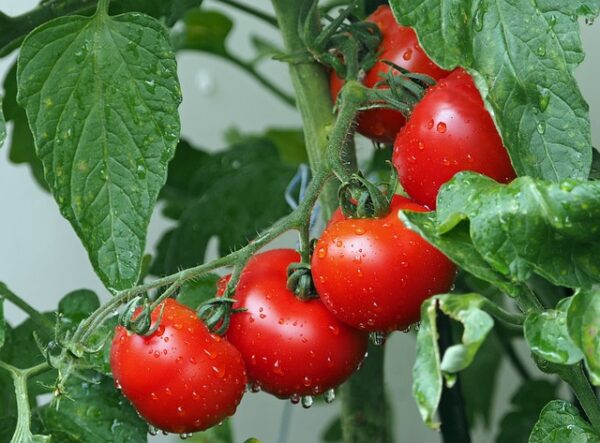Tomatoes. Human Benefits in Disease Prevention – By Dr. Harold Gunatillake


Many Sri Lankan friends have asked me about the health benefits of tomatoes, especially about prostate cancer, which most Sri Lankans fear and quite common too with longevity.
Prostate cancer is the second most common cancer among men across the world, and it shows an increasing trend. In Sri Lanka, it is the fifth most common cancer among men. Prostate cancer is rare in men younger than 40, but the chance of having prostate cancer rises rapidly after age 50.
Tomatoes, ripe fruits of the plant Solanum lycopersicum, are rich in nutrients like vitamins, minerals, and phytonutrients. Their comprehensive nutritional composition is around 94-95% water, 3- 2% carbohydrates, 1% fibre, and less than 1% proteins, lipids, vitamins, and minerals.
Vitamins and Minerals: Tomatoes are a relatively good source of several vitamins and minerals, especially 100 g of raw tomatoes, which offer around 13% of vitamin C, 18% of vitamin K, and 28% of vitamin E, respectively. Tomatoes also contain a significant amount of potassium, molybdenum, phosphorus, copper, magnesium, iron, and manganese.
Phytonutrients: There is a wealth of phytonutrient antioxidants available in tomatoes. Three categories of phytonutrient antioxidants are found in tomatoes. (1) The first category is carotenoids, fat-soluble liquid natural pigments contributing to the vivid colouration. The most commonly known dietary carotenoids are lycopene, alpha carotene, beta-carotene, and lutein. Lycopene is present in the highest amounts in tomatoes, accounting for 80-85% of total serum carotenoids. Apart from lycopene, Tomatoes also contain a higher concentration of phytofluene, phytoene, beta-carotene, and neurosporene in lower amounts. The second category of antioxidants is flavonols like quercetin, kaempferol, myricetin, and rutin. The third category is hydroxycinnamic acids, such as caffeic acid, ferulic acid, coumaric acid, and a small amount of flavanones. These antioxidants present in tomatoes contribute to promoting health.
Tomatoes carry a panoply of health benefits, and consuming them regularly can benefit and protect health while helping to prevent many diseases and conditions. Raw and cooked tomatoes are a good source of vitamins, minerals, antioxidants, and other bioactive constituents beneficial for many body functions. They protect the immune system, maintain good skin health, and manage body weight. Moreover, eating plenty of
fresh or processed tomatoes and tomato-based or flavoured products may contribute to beneficial effects. At the same time, a more significant number of intakes can be required for their isolated bioactive constituents.
Line data have shown that lycopene prevented cell proliferation and induction of apoptosis in PC3 cells (prostate cancer cells) by reducing the expression of AKT2 and increasing the expression of miR let-7f1 (microRNA Lethal-7).
Lycopene and other compounds found in tomatoes are highly regarded for their potential health benefits, including their antioxidant properties. Antioxidants are substances that can neutralise free radicals produced by the body or absorbed from
the environment. Free radicals can cause oxidative stress, damaging various macromolecules, DNA, and cellular structures, a factor linked to numerous chronic diseases. With disease prevention increasingly being raised as a critical strategy to
manage healthcare needs, antioxidants such as those found in tomatoes offer potential avenues as health-supportive factors through diet.
A high intake of tomatoes and tomato products has been linked to a lower incidence of certain diseases, such as cardiovascular diseases and different types of cancer. According to the 5-a-day initiative and based on current scientific knowledge, tomatoes, as a fruit high in antioxidants, should be included in a balanced diet for health.
The potassium and vitamin C in tomatoes support heart health by helping to lower blood pressure and reduce the risk of heart disease.
A study showed that tomatoes, when cooked semi-continuously for 30 minutes, were resistant to degradation by the cooking medium, and the concentration of the antioxidant lycopene increased in the final serving compared to the over half-fold decrease reported in briefly cooked samples. Extensive research into the properties of lycopene has shown an association with reducing the risk of cardiovascular disease predominantly due to a direct link with the oxidation of the harmful low-density lipoprotein, but also an association with decreasing skin damage caused by UV light when combined with other protective nutrients such as vitamins C and E.
Whole, fresh tomatoes and tomato products are generally demonstrated to provide a surplus of protection against chronic disease. The self-contained energy nutrient called fat in lycopene is mainly beneficial as a lipid nutrient. However, the relationship between lycopene and prostate cancer protection is reported to only be helpful in conjunction with lycopene dietary intake. Therefore, lifestyles and diets are not solely impacted by tomatoes’ body protection. Indeed, they respond to and thereby shape one
another.
The benefits of tomato intake in managing cardiovascular risk are well corroborated by the available outcomes of scientific research. Such benefits are mainly due to their content of multiple vitamins and nutrients, based on the antioxidative and antiinflammatory properties, and the improvement of lipid profile and glucose metabolism. A diet rich in vegetables and fruits has been shown to decrease the risk of developing various age-related diseases, particularly CVDs, with different fruits and vegetables playing a role. It has been emphasised that a diet high in tomatoes has been strongly correlated with an improvement in risk factors for CVD, particularly with the consumption of at least ten servings of tomato-based foods per week, combined with at least 80 millilitres of extra virgin olive oil each day and roughly five servings a day of whole grains.
The reduced risk of developing cancer upon tomato consumption is commonly formulated by proposing a biological scenario where antioxidants and their red carotenoid pigments, along with antiinflammatory elements, can act by several mechanisms, including inhibition of DNA damage, whether or not initiated by genotoxic
compounds, and of damage to mitochondrial DNA, adduct formation, and lipid or protein damage causing eventual turnover of such damaged molecules at the cell level.
Data from a relevant experimental setup suggest that tomato drinks also reduce systemic endothelial activation, having an antiatherosclerotic effect. The modern spiral view of cancer aetiology encompasses both genotoxic and epigenetic molecules, and they appear amenable to food antioxidants. The overall dietary pattern containing tomatoes is essential because it exerts a significant net athero-preventive effect as part of a broader cancer-preventive strategy.
Eye Health: The beta-carotene and lutein in tomatoes benefit eye health, helping protect against age-related macular degeneration.
I hope this article emphasises the importance of consuming raw or cooked tomatoes to benefit your health and longevity.
End
























